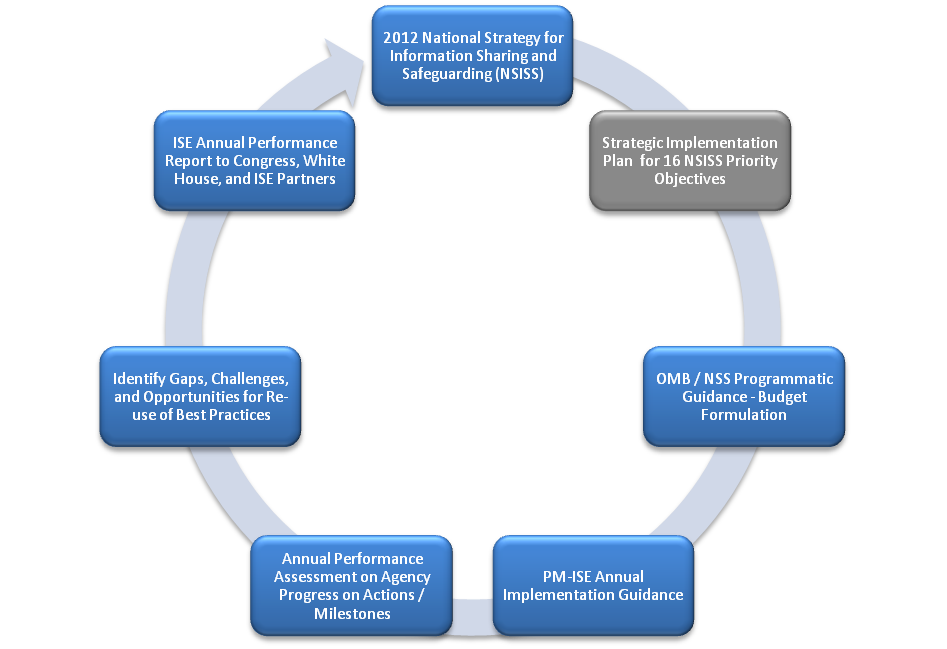
STRATEGIC IMPLEMENTATION PLAN
FOR THE NATIONAL STRATEGY FOR INFORMATION SHARING AND SAFEGUARDING
December 2013
Executing the Implementation Plan
In coordination with the National Security Staff, the ISE Management Plan, which incorporates the ISE’s Annual Planning Cycle (Figure 1 below), provides the framework for managing the Strategic Implementation Plan and provides the ability to respond to changing priorities and individual department and agency resource allocations while integrating annual programmatic[1] and implementation guidance and assigning departments and agencies specific actions and milestones.

This Strategic Implementation Plan establishes a construct for executing the Strategy by aligning each of the 16 Priority Objectives identified in the Strategy (see Appendix A) against the five strategic goals. The ISE Management Plan provides common business processes and tools to enable stakeholder collaboration while executing the Strategy.
GOAL 1: Drive Collective Action through Collaboration and Accountability
Use governance models that enable mission achievement; adopt common processes to build trust, simplify the information sharing agreement development process, and support progress through performance management, training, and incentives.
GOAL 2: Improve Information Discovery and Access through Common Standards
Improve discovery and access by developing clear policies for making information available to approved individuals through identity, authentication, and authorization controls, data tagging, enterprise-wide data correlation, common information sharing standards, and a rigorous process to certify and validate individual use.
GOAL 3: Optimize Mission Effectiveness through Shared Services and Interoperability
Optimize mission effectiveness through shared services, data and network interoperability, and increased efficiency in acquisition.
GOAL 4: Strengthen Information Safeguarding through Structural Reform, Policy, and Technical Solutions
Foster trust and safeguard our information through policy and coordinating bodies focusing on identifying, preventing, and mitigating insider threats and external intrusions, while departments and agencies work to enhance capabilities for data-level controls, automated monitoring, and cross-classification solutions.
GOAL 5: Protect Privacy, Civil Rights, and Civil Liberties through Consistency and Compliance
Maintain the public trust by increasing the consistency by which Federal departments and agencies apply privacy, civil rights, and civil liberties protections across the government, building corresponding safeguards into the development of information sharing operations, and promoting accountability and compliance mechanisms.
Safeguarding and the Protection of Individual Privacy, Civil Rights, and Civil Liberties Under the Rule of Law
A fundamental precept of the Strategic Implementation Plan is that the Federal Government’s actions must be consistent with the Constitution and in compliance with U.S. laws and regulations. Departments and agencies are responsible for identifying and complying with the law governing their activities and respec¬tive authorities. Compliance with the rule of law, particularly ensuring protection of First Amendment rights, and safeguarding our national security data are central to the Strategy and the execution of the Strategic Implementation Plan.
Roles and Responsibilities
The Strategic Implementation Plan assigns Stewards for each Priority Objective listed in the Strategy. Stewards have primary responsibility for coordinating, integrating, and synchronizing activities to achieve the Priority Objectives and the overall goals of the Strategy.
Expectations of Stewards, Departments, and Agencies
Steward
A governance entity (e.g., a department, agency, sub-committee, or working group) is responsible for leading partners[2] to take action and ensuring activities are effectively executed. The Steward is accountable for, among other things:
- Fostering communication among partners to ensure all parties understand how to complete the activity;
- Identifying, in collaboration with partners, the actions and resources needed to effectively execute the activity;
- Identifying and raising issues that impede progress; and
- Informing all departments and agencies on progress by the Steward and other Priority Objective partners, including impediments, modifications, or alterations to individual Priority Objective implementation plans.
Departments and Agencies
Collaborate with a Steward and other partners, to include state, local, tribal, territorial, and private sector partners, to accomplish an activity. Departments and agencies are accountable for:
- Accomplishing actions within their respective department or agency’s area of responsibility in a manner that contributes to the effective execution of an activity;
- Providing status reports and assessments of progress on actions pertinent to the activity; and
- Identifying needs that impede progress on their department or agency’s activities and prioritize the same needs within existing resources.
Go to the next section: Priority Objective 1: Governance
[1] NSS and OMB Programmatic Guidance is issued only when significant program changes are expected of Federal Government agencies.
[2] Partners are any supporting entity identified by the Steward as integral to the successful completion of desired outcomes; e.g., ISA IPC subcommittees, working groups, or any department or agency.